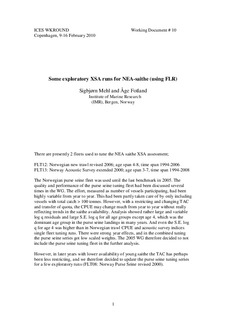| dc.description.abstract | S.E_Log q residuals and scaled weights from XSA diagnostics are presented together with estimates of Fbar and SSB in the final assessment year for 10 different single and multi fleet runs. The purse seine tuning series showed the highest S.E_Log q residuals and lowest scaled weights and did not seem to perform any better than in previous analysis. It is therefore doubtful if there are any strong reasons to reintroduce this tuning series in the assessment.
The acoustic survey indices got best results for the youngest age groups, but seem to perform reasonably well for older ones also, and it could be considered to extend the age span to age group 9.
When it comes to the six different trawl CPUE tuning fleets, the one including all vessels above the median length, days with >20% and <80% saithe and averaging over Q1-4 seems to give the best and most stable results, though there are only minor differences between some of the series. One of the series based on the 7 vessels proposed by the industry also performs reasonably well. However, as pointed out in another WD, there are both holes and outliers in the data basis from the 7 vessels, and for the time being it is perhaps best to use time series based on more vessels.
The CPUE indices got higher scaled weights in the XSA for older ages, while for age- groups 3-4 this tuning fleet is down-weighted. Age group 3 is rarely represented in landings for the later part of the time period 1994-2008 and should not be included in the tuning series, and perhaps age group 4 also should be excluded. S.E_Log q residuals and scaled weights for age group 9 are in the same range as for age group 9 from the survey, while age group 10 indices from the CPUE series got higher scaled weight in the XSA. However, regarding the high S.E_Log q residuals for age group 9, both age groups could be left out in the CPUE tuning series. | en_US |
